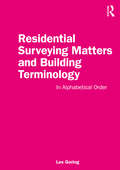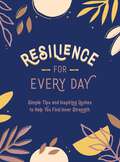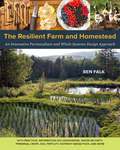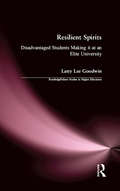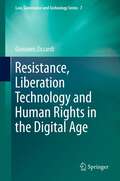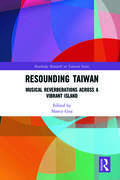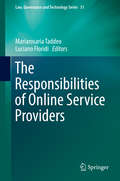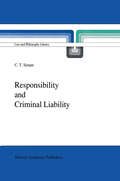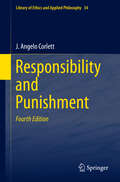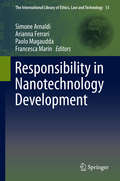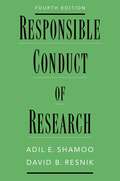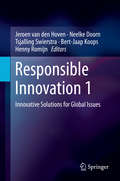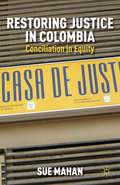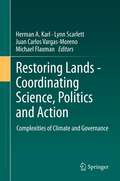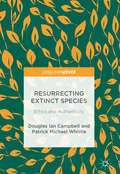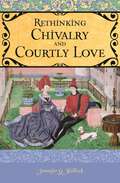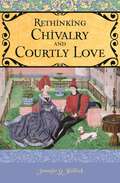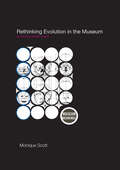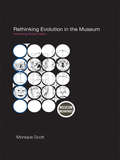- Table View
- List View
Residential Surveying Matters and Building Terminology: In Alphabetical Order
by Les GoringThis is an ideal reference book for students (undergraduates and postgraduates) studying Building Surveying, Quantity Surveying, or Architecture, etc. It should also be of use to the Construction-related legal profession, Property Managers and Letting Agents. Builders (and homeowners, interested in identifying faults in their property), should also benefit from this book. Residential Surveying Matters and Building Terminology covers a wide range of new and old building terms, techniques, technologies and materials, but much more extensively than the average dictionary. The alphabetical format makes it easy to check up on terms and subject-areas quickly – and the detailed coverage (including helpful drawings by the author) provides clear guidance to the reader. This book covers a multitude of subject-areas, including condensation problems, cellar rot, wet rot and dry rot, thermal cracks, settlement cracks, metal wall-tie corrosion-and-expansion cracks, subsidence cracks, roof-spread recognition, bulging- and/or leaning-walls, etc. Further subject areas include inspecting and analysing residential building-structures, both internally and externally; appraising underground drainage systems; and personal commentary on survey report writing.
Resilience for Every Day: Simple Tips and Inspiring Quotes to Help You Find Inner Strength
by Summersdale PublishersLife isn’t always a stroll in the sunshine, but there are ways of weathering the storms. This pocket-sized book of heartening quotations and simple but effective tips will help you summon your inner reserves and bounce back from adversity stronger than ever.
The Resilient Farm and Homestead: An Innovative Permaculture and Whole Systems Design Approach
by Ben FalkThe Resilient Farm and Homestead is a manual for developing durable, beautiful, and highly functional human habitat systems fit to handle an age of rapid transition. Ben Falk is a land designer and site developer whose permaculture-research farm has drawn national attention. The site is a terraced paradise on a hillside in Vermont that would otherwise be overlooked by conventional farmers as unworthy farmland. Falk’s wide array of fruit trees, rice paddies (relatively unheard of in the Northeast), ducks, nuts, and earth-inspired buildings is a hopeful image for the future of regenerative agriculture and modern homesteading. The book covers nearly every strategy Falk and his team have been testing at the Whole Systems Research Farm over the past decade, as well as experiments from other sites Falk has designed through his off-farm consulting business. The book includes detailed information on earthworks; gravity-fed water systems; species composition; the site-design process; site management; fuelwood hedge production and processing; human health and nutrient-dense production strategies; rapid topsoil formation and remineralization; agroforestry/silvopasture/grazing; ecosystem services, especially regarding flood mitigation; fertility management; human labor and social-systems aspects; tools/equipment/appropriate technology; and much more, complete with gorgeous photography and detailed design drawings. The Resilient Farm and Homestead is more than just a book of tricks and techniques for regenerative site development, but offers actual working results in living within complex farm-ecosystems based on research from the “great thinkers” in permaculture, and presents a viable home-scale model for an intentional food-producing ecosystem in cold climates, and beyond. Inspiring to would-be homesteaders everywhere, but especially for those who find themselves with “unlikely” farming land, Falk is an inspiration in what can be done by imitating natural systems, and making the most of what we have by re-imagining what’s possible. A gorgeous case study for the homestead of the future.
Resilient Spirits: Disadvantaged Students Making it at an Elite University (RoutledgeFalmer Studies in Higher Education)
by Latty Lee GoodwinThis study explores the identity construction of socioeconomically and educationally disadvantaged students who enter an elite university. This critical ethnography gathered qualitative data about the twenty-three participants through non-participant observation, in-depth interviews, and focus groups. Faculty, staff, and administrators were also interviewed.
Resilient Spirits: Disadvantaged Students Making it at an Elite University (RoutledgeFalmer Studies in Higher Education)
by Latty Lee GoodwinThis study explores the identity construction of socioeconomically and educationally disadvantaged students who enter an elite university. This critical ethnography gathered qualitative data about the twenty-three participants through non-participant observation, in-depth interviews, and focus groups. Faculty, staff, and administrators were also interviewed.
Resistance, Liberation Technology and Human Rights in the Digital Age (Law, Governance and Technology Series #7)
by Giovanni ZiccardiThis book explains strategies, techniques, legal issues and the relationships between digital resistance activities, information warfare actions, liberation technology and human rights. It studies the concept of authority in the digital era and focuses in particular on the actions of so-called digital dissidents. Moving from the difference between hacking and computer crimes, the book explains concepts of hacktivism, the information war between states, a new form of politics (such as open data movements, radical transparency, crowd sourcing and “Twitter Revolutions”), and the hacking of political systems and of state technologies. The book focuses on the protection of human rights in countries with oppressive regimes.
Resounding Taiwan: Musical Reverberations Across a Vibrant Island (Routledge Research on Taiwan Series)
by Nancy GuyThis book vibrantly demonstrates how the study of music allows for identification and interpretation of the forces that form Taiwanese society, from politics and policy to reactions to and assertions of such policies. Contributors to this edited volume explore how music shapes life — and life shapes music — in Taiwan, focusing on subjects ranging from musical life under Japanese colonial rule (1895–1945) through to the contemporary creations of Indigenous musicians, popular music performance and production, Christian religious music, traditional ritual music and theatre, conceptions about sound and noise, and garbage truck music's role in reducing household waste. The volume’s twelve chapters present diverse approaches to their sounding subjects, some deeply rooted in the methods and concerns explored by Taiwan's first generation of ethnomusicologists. Others employ current social theories. Presenting a window into the cultural lives of the residents of this multicultural, politically contested island, Resounding Taiwan will appeal to students and scholars of musicology and ethnomusicology, anthropology and Asian studies more widely.
Resounding Taiwan: Musical Reverberations Across a Vibrant Island (Routledge Research on Taiwan Series)
by Nancy GuyThis book vibrantly demonstrates how the study of music allows for identification and interpretation of the forces that form Taiwanese society, from politics and policy to reactions to and assertions of such policies. Contributors to this edited volume explore how music shapes life — and life shapes music — in Taiwan, focusing on subjects ranging from musical life under Japanese colonial rule (1895–1945) through to the contemporary creations of Indigenous musicians, popular music performance and production, Christian religious music, traditional ritual music and theatre, conceptions about sound and noise, and garbage truck music's role in reducing household waste. The volume’s twelve chapters present diverse approaches to their sounding subjects, some deeply rooted in the methods and concerns explored by Taiwan's first generation of ethnomusicologists. Others employ current social theories. Presenting a window into the cultural lives of the residents of this multicultural, politically contested island, Resounding Taiwan will appeal to students and scholars of musicology and ethnomusicology, anthropology and Asian studies more widely.
The Responsibilities of Online Service Providers (Law, Governance and Technology Series #31)
by Mariarosaria Taddeo Luciano FloridiThis volume focuses on the responsibilities of online service providers (OSPs) in contemporary societies. It examines the complexity and global dimensions of the rapidly evolving and serious challenges posed by the exponential development of Internet services and resources. It looks at the major actors – such as Facebook, Google, Twitter, and Yahoo! – and their significant influence on the informational environment and users’ interactions within it, as well as the responsibilities and liabilities such influence entails. It discusses the position of OSPs as information gatekeepers and how they have gone from offering connecting and information-sharing services to paying members to providing open, free infrastructure and applications that facilitate digital expression and the communication of information. The book seeks consensus on the principles that should shape OSPs’ responsibilities and practices, taking into account business ethics and policies. Finally, it discusses the rights of users and international regulations that are in place or currently lacking.
Responsibility and Criminal Liability (Law and Philosophy Library #7)
by C.T. Sistareautonomy principally in tenns of the agent's conscious choice of ends or conduct. From this, the cognitivist emphasis on mental states and their contents naturally follows. The presence of specified mental states, as signifying agent choice, thus becomes the hallmark of responsible conduct. Capacities model theorists, by contrast, interpret personal autonomy and agent responsibility in tenns of the looser notion of 'control'. From this perspective, conscious choosing is but one (highly responsible) instance of such control, and the presence or absence of mental states is primarily relevant to detennining degrees of responsibility. The examination of these two models occupies the bulk of this manuscript. Exploration of the capacities model and criticism of the orthodox view also generate treatment of legal issues such as the use of negligence liability, the nature of criminal omissions, the character of various legal defenses, and so on. Chapters 2 and 3 set out some of the thematic arguments outlined above and introduce tenninology and useful distinctions. Chapters 4 through 7 provide substantive analyses of agent responsibility and of standards of criminal liability. In these chapters, I argue for the comparative superiority of the capacities model of responsibility and offer recommendations for changes in current legal conceptions and standards of liability. Each chapter centers on an element of individual responsibility and related legal concerns. The final chapter, Chapter 8, comprises an overview of the integrated theory of responsibility and liability and its comparison with the traditional view.
Responsibility and Punishment (Library of Ethics and Applied Philosophy #34)
by J. Angelo CorlettThis volume provides discussions of both the concept of responsibility and of punishment, and of both individual and collective responsibility. It provides in-depth Socratic and Kantian bases for a new version of retributivism, and defends that version against the main criticisms that have been raised against retributivism in general. It includes chapters on criminal recidivism and capital punishment, as well as one on forgiveness, apology and punishment that is congruent with the basic precepts of the new retributivism defended therein. Finally, chapters on corporate responsibility and punishment are included, with a closing chapter on holding the U.S. accountable for its most recent invasion and occupation of Iraq. The book is well-focused but also presents the widest ranging set of topics of any book of its kind as it demonstrates how the concepts of responsibility and punishment apply to some of the most important problems of our time.“This is one of the best books on punishment, and the Fourth Edition continues its tradition of excellence. The book connects punishment importantly to moral responsibility and desert, and it is comprehensive in its scope, both addressing abstract, theoretical issues and applied issues as well. The topics treated include collective responsibility, apology, forgiveness, capital punishment, and war crimes. Highly recommended.”—John Martin Fischer, Distinguished Professor of Philosophy, University of California, Riverside.
Responsibility in Nanotechnology Development (The International Library of Ethics, Law and Technology #13)
by Simone Arnaldi Arianna Ferrari Paolo Magaudda Francesca MarinThis book disentangles the complex meanings of responsibility in nanotechnology development by focusing on its theoretical and empirical dimensions. The notion of responsibility is extremely diversified in the public discourse of nanoscale technologies. Addressed are major disciplinary perspectives working on nanotechnology, e.g. philosophy, sociology, and political science, as well as the major multidisciplinary areas relevant to the innovation process, e.g. technology assessment and ethics. Furthermore, the interplay between such expertises, disciplines, and research programmes in providing a multidisciplinary understanding of responsibility is emphasized.
Responsible Conduct of Research
by David B. Resnik Adil E. ShamooResponsible Conduct of Research provides an overview of ethical, legal, and social issues in scientific research for science students, trainees, and professional scientists. This book gives an in-depth analysis of a wide array of topics, including ethical theory and decision-making, misconduct, questionable research practices, research record-keeping, data sharing, data auditing, reproducibility, authorship, publication, peer review, intellectual property, conflict of interest, mentoring, safe research environment, animal experimentation, research with human subjects, and social responsibility. Authors Adil E. Shamoo and David B. Resnik include several case studies and questions at the end of each chapter that can serve as a basis for further analysis and discussion. The concluding chapter of the book describes some steps that researchers, institutional officials, government agencies, and scientific organizations can take to promote ethical conduct in scientific research. In this 4th edition of Responsible Conduct of Research has been updated to include references and discussions of new and evolving topics, such as digital image manipulation, self-plagiarism, retractions, publication on pre-print servers, harassment, research with human biological samples, revisions to the Common Rule for research with human subjects, dual use research, the COVID-19 pandemic, providing science advice, and interactions with the media.
Responsible Conduct of Research
by Adil E. Shamoo David B. ResnikResponsible Conduct of Research provides an overview of ethical, legal, and social issues in scientific research for science students, trainees, and professional scientists. This book gives an in-depth analysis of a wide array of topics, including ethical theory and decision-making, misconduct, questionable research practices, research record-keeping, data sharing, data auditing, reproducibility, authorship, publication, peer review, intellectual property, conflict of interest, mentoring, safe research environment, animal experimentation, research with human subjects, and social responsibility. Authors Adil E. Shamoo and David B. Resnik include several case studies and questions at the end of each chapter that can serve as a basis for further analysis and discussion. The concluding chapter of the book describes some steps that researchers, institutional officials, government agencies, and scientific organizations can take to promote ethical conduct in scientific research. In this 4th edition of Responsible Conduct of Research has been updated to include references and discussions of new and evolving topics, such as digital image manipulation, self-plagiarism, retractions, publication on pre-print servers, harassment, research with human biological samples, revisions to the Common Rule for research with human subjects, dual use research, the COVID-19 pandemic, providing science advice, and interactions with the media.
Responsible History (n/a)
by Antoon De Baets“I can warmly recommend Responsible History to any concerned historian in need of a reliable compass for responsible conduct. I endorse Voltaire’s words quoted in this book: ‘Those who can make you believe absurdities, can make you commit atrocities.’ Responsible conduct is necessary because irresponsible conduct is dangerous.” [From the Foreword.] The abuse of history is common and quite possibly once more on the rise. Although this is well documented, there is no general theory that enables historians to identify, prove, explain, and evaluate the many types of abuse of history. In this book, the author, founder of the Network of Concerned Historians, presents such a theory. Reflecting on the responsible use of history, the author identifies the duties that the living has toward the dead and analyzes the rights to memory and history necessary to fulfill these duties. He concludes his powerful argument by proposing a code of ethics as a guide for responsible historians. This work is vital for any historian who wants to oppose and prevent the abuse of history.
Responsible Innovation 1: Innovative Solutions for Global Issues
by Jeroen van den Hoven Neelke Doorn Tsjalling Swierstra Bert-Jaap Koops Henny RomijnThis book addresses the methodological issues involved in responsible innovation and provides an overview of recent applications of multidisciplinary research. Responsible innovation involves research into the ethical and societal aspects of new technologies (e.g. ICT, nanotechnology, biotechnology and brain sciences) and of changes in technological systems (e.g. energy, transport, agriculture and water). This research is highly multidisciplinary. It involves close collaboration between researchers in such diverse fields as ethics, social science, law, economics, applied science, engineering - as well as innovative, design-oriented and policy-relevant. Although there is a trend to engage ethicists and social scientists early in technology development, most literature in the field of Technology Assessment or Ethics of Technology is still aimed at one discipline whereas this book incorporates different approaches and to discuss experiences, lessons and more general theoretical issues.
Restoring Justice in Colombia: Conciliation in Equity
by S. MahanExamining the 'Conciliation in Equity' program in Colombia, this book provides a dramatic, cross-cultural example of community justice and a model for developing alternative methods of resolving crime and conflict.
Restoring Lands - Coordinating Science, Politics and Action: Complexities of Climate and Governance
by Herman A. Karl, Lynn Scarlett, Juan Carlos Vargas-Moreno and Michael FlaxmanEnvironmental issues, vast and varied in their details, unfold at the confluence of people and place. They present complexities in their biophysical details, their scope and scale, and the dynamic character of human action and natural systems. Addressing environmental issues often invokes tensions among battling interests and competing priorities. Air and water pollution, the effects of climate change, ecosystem transformations—these and other environmental issues involve scientific, social, economic, and institutional challenges. This book analyzes why tackling many of these problems is so difficult and why sustainability involves more than adoption of greener, cleaner technologies. Sustainability, as discussed in this book, involves knowledge flows and collaborative decision processes that integrate scientific and technological methods and tools, political and governance structures and regimes, and social and community values. The authors synthesize a holistic and adaptive approach to rethinking the framework for restoring healthy ecosystems that are the foundation for thriving communities and dynamic economies. This approach is that of collective action. Through their research and practical experiences, the authors have learned that much wisdom resides among diverse people in diverse communities. New collaborative decision-making institutions must reflect that diversity and tap into its wisdom while also strengthening linkages among scientists and decision makers.From the pre-publication reviews:“Finally, we have a book that explains how science is irrelevant without people. It’s people who decide when and how to use science, not scientists. This book gives us a roadmap for how to really solve complex problems. It involves hard work, and creating new relationships between scientists and the public that don’t typically exist in our society.” -John M. Hagan, Ph.D.President, Manomet Center for Conservation Sciences
Resurrecting Extinct Species: Ethics and Authenticity
by Douglas Ian Campbell Patrick Michael WhittleThis book is about the philosophy of de-extinction. To make an extinct species ‘de-extinct’ is to resurrect it by creating new organisms of the same, or similar, appearance and genetics. The book describes current attempts to resurrect three species, the aurochs, woolly mammoth and passenger pigeon. It then investigates two major philosophical questions such projects throw up. These are the Authenticity Question—‘will the products of de-extinction be authentic members of the original species?’—and the Ethical Question—‘is de-extinction something that should be done?' The book surveys and critically evaluates a raft of arguments for and against the authenticity or de-extinct organisms, and for and against the ethical legitimacy of de-extinction. It concludes, first, that authentic de-extinctions are actually possible, and second, that de-extinction can potentially be ethically legitimate, especially when deployed as part of a ‘freeze now and resurrect later’ conservation strategy.
Resurrecting Extinct Species: Ethics and Authenticity
by Douglas Ian Campbell Patrick Michael WhittleThis book is about the philosophy of de-extinction. To make an extinct species ‘de-extinct’ is to resurrect it by creating new organisms of the same, or similar, appearance and genetics. The book describes current attempts to resurrect three species, the aurochs, woolly mammoth and passenger pigeon. It then investigates two major philosophical questions such projects throw up. These are the Authenticity Question—‘will the products of de-extinction be authentic members of the original species?’—and the Ethical Question—‘is de-extinction something that should be done?' The book surveys and critically evaluates a raft of arguments for and against the authenticity or de-extinct organisms, and for and against the ethical legitimacy of de-extinction. It concludes, first, that authentic de-extinctions are actually possible, and second, that de-extinction can potentially be ethically legitimate, especially when deployed as part of a ‘freeze now and resurrect later’ conservation strategy.
The Retail Revolution in Health Care
by Myron D. Fottler Donna M. MalveyThis book unveils and demystifies a revolution occurring in health care in the United States and beyond and how it will reform the health care system.There is something new in health care. Retail clinics, sometimes partnering with prestigious health-care institutions such as the Cleveland Clinic, offer an affordable, accessible solution for delivering primary-care services to underserved populations. The Retail Revolution in Health Care presents an overview of the retail health trend and its implications for consumers, employers, health care providers, health care companies, insurers, and health policy makers.The authors examine the phenomenon of retail health care from an entrepreneurial perspective, discussing the growth of retail care beyond traditional retail establishments and possible performance indicators to assess health outcomes. They report on the differing perspectives of retail care from a variety of experts, including doctors, nurses, patients, and insurers. Finally, they address business realities in the United States and globally as they affect the clinics. Retail clinics will almost certainly play a key role as either an alternative to national health insurance or a component of health reform. This important book explores their part in furthering the availability of health care for all Americans.
Rethinking Chivalry and Courtly Love (Praeger Series on the Middle Ages)
by Jennifer G. WollockThis book offers an overview of the origins, growth, and influence of chivalry and courtly love, casting new light on the importance of these medieval ideals for understanding world history and culture to the present day.Rethinking Chivalry and Courtly Love shows that these two interlinked medieval era concepts are best understood in light of each other. It is the first book to explore the multicultural origins of chivalry and courtly love in tandem, tracing their sources back to the ancient world, then follow their development—separately and together—through medieval life and literature. In addition to examining the history of chivalry and courtly love, this remarkable volume looks at their enduring legacy—not just in popular media but in molding our present-day concepts of human rights, professional ethics, military conduct, and gender relations. Readers will see how understanding the tenets of the chivalrous life helps us understand our own world today.
Rethinking Chivalry and Courtly Love (Praeger Series on the Middle Ages)
by Jennifer G. WollockThis book offers an overview of the origins, growth, and influence of chivalry and courtly love, casting new light on the importance of these medieval ideals for understanding world history and culture to the present day.Rethinking Chivalry and Courtly Love shows that these two interlinked medieval era concepts are best understood in light of each other. It is the first book to explore the multicultural origins of chivalry and courtly love in tandem, tracing their sources back to the ancient world, then follow their development—separately and together—through medieval life and literature. In addition to examining the history of chivalry and courtly love, this remarkable volume looks at their enduring legacy—not just in popular media but in molding our present-day concepts of human rights, professional ethics, military conduct, and gender relations. Readers will see how understanding the tenets of the chivalrous life helps us understand our own world today.
Rethinking Evolution in the Museum: Envisioning African Origins (Museum Meanings)
by Monique ScottRethinking Evolution in the Museum explores the ways diverse natural history museum audiences imagine their evolutionary heritage. In particular, the book considers how the meanings constructed by audiences of museum exhibitions are a product of dynamic interplay between museum iconography and powerful images museum visitors bring with them to the museum. In doing so, the book illustrates how the preconceived images held by museum audiences about anthropology, Africa, and the museum itself strongly impact the human origins exhibition experience. Although museological theory has come increasingly to recognize that museum audiences ‘make meaning’ in exhibitions, or make their own complex interpretations of museum exhibitions, few scholars have explicitly asked how. Rethinking Evolution in the Museum, however, provides a rare window into visitor perceptions at four world-class museums—the Natural History Museum and Horniman Museum in London, the National Museums of Kenya in Nairobi and the American Museum of Natural History in New York. Through rigorous and novel mixed methods (quantitative and qualitative) covering nearly 500 museum visitors, this innovative study shows that audiences of human origins exhibitions interpret evolution exhibitions through a profoundly complex convergence of personal, political, intellectual, emotional and cultural interpretive strategies. This book also reveals that natural history museum visitors often respond to museum exhibitions similarly because they use common cultural tools picked up from globalized popular media circulating outside of the museum. One tool of particular interest is the notion that human evolution has proceeded linearly from a bestial African prehistory to a civilized European present. Despite critical growths in anthropological science and museum displays, the outdated Victorian progress motif lingers persistently in popular media and the popular imagination. Rethinking Evolution in the Museum sheds light on our relationship with natural history museums and will be crucial to those people interested in understanding the connection between the visitor, the museum and media culture outside of the museum context.
Rethinking Evolution in the Museum: Envisioning African Origins (Museum Meanings)
by Monique ScottRethinking Evolution in the Museum explores the ways diverse natural history museum audiences imagine their evolutionary heritage. In particular, the book considers how the meanings constructed by audiences of museum exhibitions are a product of dynamic interplay between museum iconography and powerful images museum visitors bring with them to the museum. In doing so, the book illustrates how the preconceived images held by museum audiences about anthropology, Africa, and the museum itself strongly impact the human origins exhibition experience. Although museological theory has come increasingly to recognize that museum audiences ‘make meaning’ in exhibitions, or make their own complex interpretations of museum exhibitions, few scholars have explicitly asked how. Rethinking Evolution in the Museum, however, provides a rare window into visitor perceptions at four world-class museums—the Natural History Museum and Horniman Museum in London, the National Museums of Kenya in Nairobi and the American Museum of Natural History in New York. Through rigorous and novel mixed methods (quantitative and qualitative) covering nearly 500 museum visitors, this innovative study shows that audiences of human origins exhibitions interpret evolution exhibitions through a profoundly complex convergence of personal, political, intellectual, emotional and cultural interpretive strategies. This book also reveals that natural history museum visitors often respond to museum exhibitions similarly because they use common cultural tools picked up from globalized popular media circulating outside of the museum. One tool of particular interest is the notion that human evolution has proceeded linearly from a bestial African prehistory to a civilized European present. Despite critical growths in anthropological science and museum displays, the outdated Victorian progress motif lingers persistently in popular media and the popular imagination. Rethinking Evolution in the Museum sheds light on our relationship with natural history museums and will be crucial to those people interested in understanding the connection between the visitor, the museum and media culture outside of the museum context.
